Surfactant-Triggered Molecular Gate Tested on Different Mesoporous Silica Supports for Gastrointestinal Controlled Delivery
Abstract
1. Introduction
2. Materials and Methods
2.1. Chemicals and Cell Culture Media
2.2. Mesoporous Silica Particles Synthesis
2.3. Synthesis of Solids Loaded with RhB and Capped with OA
2.4. Methods Used for Characterization
2.5. Cargo Delivery
2.6. Cargo Release Kinetics
2.7. In Vitro Digestion
2.8. Cell Culture Conditions
2.9. MTT Cell Viability Assay
2.10. In Vivo Pharmacokinetic Studies
3. Results and Discussion
3.1. Design, Synthesis and Characterization of Solids
3.2. Cargo Controlled Release
3.3. Cargo Release Kinetics
3.4. In Vitro Biocompatibility Test: Interaction with Cells of the GIT
3.5. In Vivo Pharmacokinetic Studies
4. Conclusions
Author Contributions
Funding
Acknowledgments
Conflicts of Interest
References
- Pérez-Esteve, É.; Ruiz-Rico, M.; De La Torre, C.; Llorca, E.; Sancenón, F.; Marcos, M.D.; Amorós, P.; Guillem, C.; Martínez-Máñez, R.; Barat, J.M. Stability of different mesoporous silica particles during an in vitro digestion. Microporous Mesoporous Mater. 2016, 230, 196–207. [Google Scholar] [CrossRef]
- Di Pasqua, A.J.; Sharma, K.K.; Shi, Y.L.; Toms, B.B.; Ouellette, W.; Dabrowiak, J.C.; Asefa, T. Cytotoxicity of mesoporous silica nanomaterials. J. Inorg. Biochem. 2008, 102, 1416–1423. [Google Scholar] [CrossRef] [PubMed]
- Izquierdo-Barba, I.; Colilla, M.; Manzano, M.; Vallet-Regí, M. In vitro stability of SBA-15 under physiological conditions. Microporous Mesoporous Mater. 2010, 132, 442–452. [Google Scholar] [CrossRef]
- Arruebo, M. Drug delivery from structured porous inorganic materials. Wiley Interdiscip. Rev. Nanomed. Nanobiotechnol. 2012, 4, 16–30. [Google Scholar] [CrossRef]
- Vallet-Regí, M.; Balas, F.; Arcos, D. Mesoporous materials for drug delivery. Angew. Chem. Int. Ed. 2007, 46, 7548–7558. [Google Scholar] [CrossRef]
- Descalzo, A.B.; Martínez-Máñez, R.; Sancenón, F.; Hoffmann, K.; Rurack, K. The supramolecular chemistry of organic-inorganic hybrid materials. Angew. Chem. Int. Ed. 2006, 45, 5924–5948. [Google Scholar] [CrossRef]
- Shang, L.; Bian, T.; Zhang, B.; Zhang, D.; Wu, L.Z.; Tung, C.H.; Yin, Y.; Zhang, T. Graphene-supported ultrafine metal nanoparticles encapsulated by mesoporous silica: Robust catalysts for oxidation and reduction reactions. Angew. Chem. Int. Ed. 2014, 53, 250–254. [Google Scholar] [CrossRef]
- Taguchi, A.; Schüth, F. Ordered Mesoporous Materials in Catalysis. Microporous Mesoporous Mater. 2005, 77, 1–45. [Google Scholar] [CrossRef]
- Angelos, S.; Liong, M.; Choi, E.; Zink, J.I. Mesoporous silicate materials as substrates for molecular machines and drug delivery. Chem. Eng. J. 2008, 137, 4–13. [Google Scholar] [CrossRef]
- García-Fernández, A.; Aznar, E.; Martínez-Máñez, R.; Sancenón, F. New advances in in vivo applications of gated mesoporous silica as drug delivery nanocarriers. Small 2020, 16, 1902242. [Google Scholar] [CrossRef]
- Barbé, C.; Bartlett, J.; Kong, L.; Finnie, K.; Lin, H.Q.; Larkin, M.; Calleja, S.; Bush, A.; Calleja, G. Silica particles: a novel drug‐delivery system. Adv. Mater. 2004, 16, 1959–1966. [Google Scholar] [CrossRef]
- Llopis-Lorente, A.; Lozano-Torres, B.; Bernardos, A.; Martínez-Máñez, R.; Sancenón, F. Mesoporous silica materials for controlled delivery based on enzymes. J. Mater. Chem. B 2017, 5, 3069–3083. [Google Scholar] [CrossRef]
- Mas, N.; Arcos, D.; Polo, L.; Aznar, E.; Sánchez-Salcedo, S.; Sancenón, F.; García, A.; Marcos, M.D.; Baeza, A.; Vallet-Regí, M.; et al. Towards the development of smart 3D “gated scaffolds” for on-Command delivery. Small 2014, 10, 4859–4864. [Google Scholar] [CrossRef] [PubMed]
- Santos-Figueroa, L.E.; Giménez, C.; Agostini, A.; Aznar, E.; Marcos, M.D.; Sancenón, F.; Martínez-Máñez, R.; Amorós, P. Selective and sensitive chromofluorogenic detection of the sulfite anion in water using hydrophobic hybrid organic-Inorganic silica nanoparticles. Angew. Chem. Int. Ed. 2013, 52, 13712–13716. [Google Scholar] [CrossRef] [PubMed]
- Poyatos-Racionero, E.; Ros-Lis, J.V.; Vivancos, J.-L.; Martínez-Máñez, R. Recent advances on intelligent packaging as tools to reduce food waste. J. Clean. Prod. 2018, 172, 3398–3409. [Google Scholar] [CrossRef]
- Coll, C.; Casasús, R.; Aznar, E.; Marcos, M.D.; Martínez-Máñez, R.; Sancenón, F.; Soto, J.; Amorós, P. Nanoscopic hybrid systems with a polarity-controlled gate-Like scaffolding for the colorimetric signalling of long-chain carboxylates. Chem. Commun. 2007, 1957–1959. [Google Scholar] [CrossRef]
- Pérez-Esteve, E.; Bernardos, A.; Martínez-Máñez, R.; Barat, J.M. Nanotechnology in the development of novel functional foods or their package. an overview based in patent analysis. Recent Pat. Food Nutr. Agric. 2013, 5, 35–43. [Google Scholar] [CrossRef]
- Lamprecht, A.; Schäfer, U.; Lehr, C.-M.M. Size-Dependent bioadhesion of micro- and nanoparticulate carriers to the inflamed colonic mucosa. Pharm. Res. 2001, 18, 788–793. [Google Scholar] [CrossRef]
- De Luis, B.; Llopis-Lorente, A.; Rincón, P.; Gadea, J.; Sancenón, F.; Aznar, E.; Villalonga, R.; Murguía, J.R.; Martínez-Máñez, R. An interactive model of communication between abiotic nanodevices and microorganisms. Angew. Chemie-Int. Ed. 2009, 58, 14968–14990. [Google Scholar] [CrossRef]
- Bernardos, A.; Marina, T.; Žáček, P.; Pérez-Esteve, É.; Martínez-Mañez, R.; Lhotka, M.; Kouřimská, L.; Pulkrábek, J.; Klouček, P. Antifungal effect of essential oil components against Aspergillus niger when loaded into silica mesoporous supports. J. Sci. Food Agric. 2015, 95, 2824–2831. [Google Scholar] [CrossRef]
- Barat, J.; Pérez-Esteve, É.; Bernardos, A.; Martínez-Mañez, R. Nutritional effects of folic acid controlled release from mesoporous materials. Procedia Food Sci. 2011, 1, 1828–1832. [Google Scholar] [CrossRef][Green Version]
- Ruiz-Rico, M.; Daubenschüz, H.; Pérez-Esteve, É.; Marcos, M.D.; Amorós, P.; Martínez-Máñez, R.; Barat, J.M. Protective effect of mesoporous silica particles on encapsulated folates. Eur. J. Pharm. Biopharm. 2016, 105, 9–17. [Google Scholar] [CrossRef] [PubMed]
- Bernardos, A.; Piacenza, E.; Sancenón, F.; Hamidi, M.; Maleki, A.; Turner, R.J.; Martínez-Máñez, R. Mesoporous Silica-Based Materials with Bactericidal Properties. Small 2019, 15, 1–34. [Google Scholar] [CrossRef] [PubMed]
- Awaad, A.; Nakamura, M.; Ishimura, K. Imaging of size-dependent uptake and identification of novel pathways in mouse Peyer’s patches using fluorescent organosilica particles. Nanomed. Nanotechnol. Biol. Med. 2012, 8, 627–636. [Google Scholar] [CrossRef]
- Hussain, N.; Jaitley, V.; Florence, A.T. Recent advances in the understanding of uptake of microparticulates across the gastrointestinal lymphatics. Adv. Drug Deliv. Rev. 2001, 50, 107–142. [Google Scholar] [CrossRef]
- Fu, C.; Liu, T.; Li, L.; Liu, H.; Chen, D.; Tang, F. The absorption, distribution, excretion and toxicity of mesoporous silica nanoparticles in mice following different exposure routes. Biomaterials 2013, 34, 2565–2575. [Google Scholar] [CrossRef]
- Alothman, Z.A. A review: Fundamental aspects of silicate mesoporous materials. Materials (Basel) 2012, 5, 2874–2902. [Google Scholar] [CrossRef]
- Asefa, T.; Tao, Z. Mesoporous silica and organosilica materials-Review of their synthesis and organic functionalization. Can. J. Chem. 2012, 90, 1015–1031. [Google Scholar] [CrossRef]
- Li, Y.; Li, N.; Pan, W.; Yu, Z.; Yang, L.; Tang, B. Hollow mesoporous silica nanoparticles with tunable structures for controlled drug delivery. ACS Appl. Mater. Interfaces 2017, 9, 2123–2129. [Google Scholar] [CrossRef] [PubMed]
- Legnoverde, M.S.; Basaldella, E.I. Influence of particle size on the adsorption and release of cephalexin encapsulated in mesoporous silica SBA-15. Mater. Lett. 2016, 181, 331–334. [Google Scholar] [CrossRef]
- Popova, M.; Szegedi, A.; Mavrodinova, V.; Novak Tušar, N.; Mihály, J.; Klébert, S.; Benbassat, N.; Yoncheva, K. Preparation of resveratrol-loaded nanoporous silica materials with different structures. J. Solid State Chem. 2014, 219, 37–42. [Google Scholar] [CrossRef]
- Martín, A.; Morales, V.; Ortiz-Bustos, J.; Pérez-Garnes, M.; Bautista, L.F.; García-Muñoz, R.A.; Sanz, R. Modelling the adsorption and controlled release of drugs from the pure and amino surface-functionalized mesoporous silica hosts. Microporous Mesoporous Mater. 2018, 262, 23–34. [Google Scholar] [CrossRef]
- Pérez-Esteve, É.; Ruiz-Rico, M.; De La Torre, C.; Villaescusa, L.A.; Sancenón, F.; Marcos, M.D.; Amorós, P.; Martínez-Máñez, R.; Barat, J.M. Encapsulation of folic acid in different silica porous supports: A comparative study. Food Chem. 2016, 196, 66–75. [Google Scholar] [CrossRef]
- Silveira, G.Q.; Da Silva, R.S.; Franco, L.P.; Vargas, M.D.; Ronconi, C.M. Redox-responsive nanoreservoirs: The effect of different types of mesoporous silica on the controlled release of doxorubicin in solution and in vitro. Microporous Mesoporous Mater. 2015, 206, 226–233. [Google Scholar] [CrossRef]
- Wang, S. Ordered mesoporous materials for drug delivery. Microporous Mesoporous Mater. 2009, 117, 1–9. [Google Scholar] [CrossRef]
- Donner, T.; Sarkar, S. Insulin–Pharmacology, Therapeutic Regimens, and Principles of Intensive Insulin Therapy; MDText.com, Inc.: South Dartmouth, MA, USA, 2000. [Google Scholar]
- Lu, P.J.; Hsu, P.I.; Chen, C.H.; Hsiao, M.; Chang, W.C.; Tseng, H.H.; Lin, K.H.; Chuah, S.K.; Chen, H.C. Gastric juice acidity in upper gastrointestinal diseases. World J. Gastroenterol. 2010, 16, 5496–5501. [Google Scholar] [CrossRef] [PubMed]
- Ulker, I.; Yildiran, H. The effects of bariatric surgery on gut microbiota in patients with obesity: A review of the literature. Biosci. Microbiota Food Heal. 2019, 38, 3–9. [Google Scholar] [CrossRef] [PubMed]
- Sardo, P.; Walker, J.H. Bariatric surgery: Impact on medication management. Hosp. Pharm. 2008, 43, 113–120. [Google Scholar] [CrossRef]
- De Geraldo, M.S.P.; Fonseca, F.L.A.; de Veiga Gouveia, M.R.F.; Feder, D. The use of drugs in patients who have undergone bariatric surgery. Int. J. Gen. Med. 2014, 7, 219–224. [Google Scholar] [CrossRef] [PubMed]
- Kurlan, R.; Nutt, J.G.; Woodward, W.R.; Rothfield, K.; Lichter, D.; Miller, C.; Carter, J.H.; Shoulson, I. Duodenal and gastric delivery of levodopa in parkinsonism. Ann. Neurol. 1988, 23, 589–595. [Google Scholar] [CrossRef]
- Lundqvist, C. Continuous levodopa for advanced Parkinson’s disease. Neuropsychiatr. Dis. Treat. 2007, 3, 335–348. [Google Scholar]
- Bredberg, E.; Nilsson, D.; Johansson, K.; Aquilonius, S.M.; Johnels, B.; Nyström, C.; Paalzow, L. Intraduodenal infusion of a water-Based levodopa dispersion for optimisation of the therapeutic effect in severe Parkinson’s disease. Eur. J. Clin. Pharmacol. 1993, 45, 117–122. [Google Scholar] [CrossRef]
- Antonini, A.; Odin, P. Pros and cons of apomorphine and l-dopa continuous infusion in advanced Parkinson’s disease. Park. Relat. Disord. 2009, 15, S97–S100. [Google Scholar] [CrossRef]
- Santos-García, D.; de Deus, T.; López-Pazos, E.; Macías-Arribi, M.; Llaneza-González, M.A.; de la Fuente-Fernández, R.; Echarri-Piudo, A.; Carpintero, P. Management of complications related to intraduodenal infusion of levodopa/carbidopa in patients with Parkinson’s disease. Rev. Neurol. 2014, 58, 505–515. [Google Scholar] [CrossRef]
- Poyatos-Racionero, E.; Pérez-Esteve, É.; Dolores Marcos, M.; Barat, J.M.; Martínez-Máñez, R.; Aznar, E.; Bernardos, A. New Oleic Acid-Capped Mesoporous Silica Particles as Surfactant-Responsive Delivery Systems. ChemistryOpen 2019, 8, 1052–1056. [Google Scholar] [CrossRef]
- Cabrera, S.; El Haskouri, J.; Guillem, C.; Latorre, J.; Beltrán-Porter, A.; Beltrán-Porter, D.; Marcos, M.D.; Amorós, P. Generalised syntheses of ordered mesoporous oxides: The atrane route. Solid State Sci. 2000, 2, 405–420. [Google Scholar] [CrossRef]
- Meléndez-Ortiz, H.I.; Perera-Mercado, Y.A.; García-Cerda, L.A.; Mercado-Silva, J.A.; Castruita, G. Influence of the reaction conditions on the thermal stability of mesoporous MCM-48 silica obtained at room temperature. Ceram. Int. 2014, 40, 4155–4161. [Google Scholar] [CrossRef]
- Zhao, D.; Feng, J.; Huo, Q.; Melosh, N.; Fredrickson, G.H.; Chmelka, B.F.; Stucky, G.D. Triblock Copolymer Syntheses of Mesoporous Silica with Periodic 50 to 300 Angstrom Pores. Science 1998, 279, 548–552. [Google Scholar] [CrossRef] [PubMed]
- El Haskouri, J.; de Zárate, D.O.; Guillem, C.; Latorre, J.; Caldés, M.; Beltrán, A.; Beltrán, D.; Descalzo, A.B.; Rodríguez-López, G.; Martínez-Máñez, R.; et al. Silica-Based powders and monoliths with bimodal pore systems. Chem. Commun. 2002, 2, 330–331. [Google Scholar] [CrossRef] [PubMed]
- Mathematical models of drug release. In Strategies to Modify the Drug Release from Pharmaceutical Systems; Bruschi, M.L., Ed.; Woodhead Publishing: Cambridge, UK, 2015; pp. 63–86. ISBN 9780081000922. [Google Scholar]
- Versantvoort, C.H.M.; Oomen, A.G.; Van De Kamp, E.; Rompelberg, C.J.M.; Sips, A.J.A.M. Applicability of an in vitro digestion model in assessing the bioaccessibility of mycotoxins from food. Food Chem. Toxicol. 2005, 43, 31–40. [Google Scholar] [CrossRef] [PubMed]
- Ritger, P.L.; Peppas, N.A. A simple equation for description of solute release I. Fickian and non-fickian release from non-swellable devices in the form of slabs, spheres, cylinders or discs. J. Control. Release 1987, 5, 23–36. [Google Scholar] [CrossRef]
- Huang, X.; Brazel, C.S. On the importance and mechanisms of burst release in matrix-Controlled drug delivery systems. J. Control. Release 2001, 73, 121–136. [Google Scholar] [CrossRef]
- Choi, S.J.; Kim, Y.R. Bioinspired layered nanoclays for nutraceutical delivery system. ACS Symp. Ser. 2013, 1143, 207–220. [Google Scholar] [CrossRef]
- Sgouras, D.; Duncan, R. Methods for the evaluation of biocompatibility of soluble synthetic polymers which have potential for biomedical use: 1-Use of the tetrazolium-based colorimetric assay (MTT) as a preliminary screen for evaluation of in vitro cytotoxicity. J. Mater. Sci. Mater. Med. 1990, 1, 61–68. [Google Scholar] [CrossRef]
- Yazdimamaghani, M.; Barber, Z.B.; Hadipour Moghaddam, S.P.; Ghandehari, H. Influence of Silica Nanoparticle Density and Flow Conditions on Sedimentation, Cell Uptake, and Cytotoxicity. Mol. Pharm. 2018, 15, 2372–2383. [Google Scholar] [CrossRef]
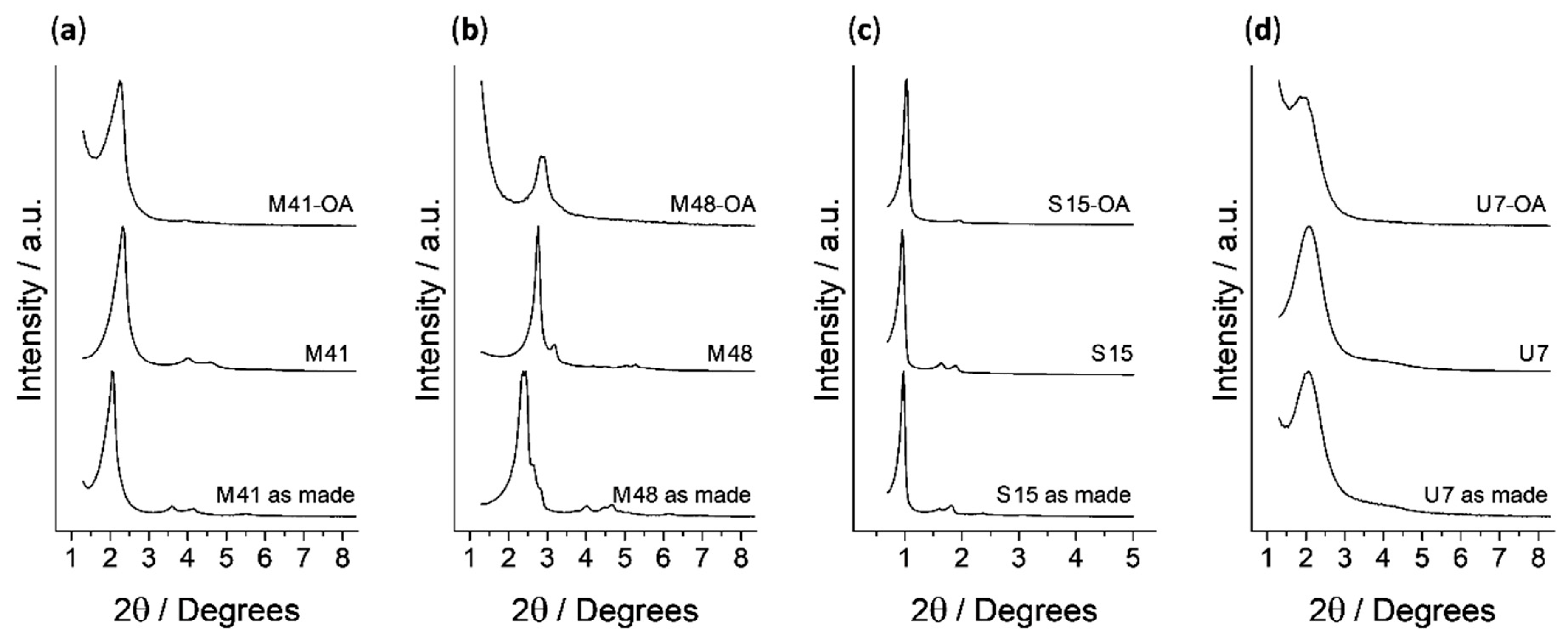
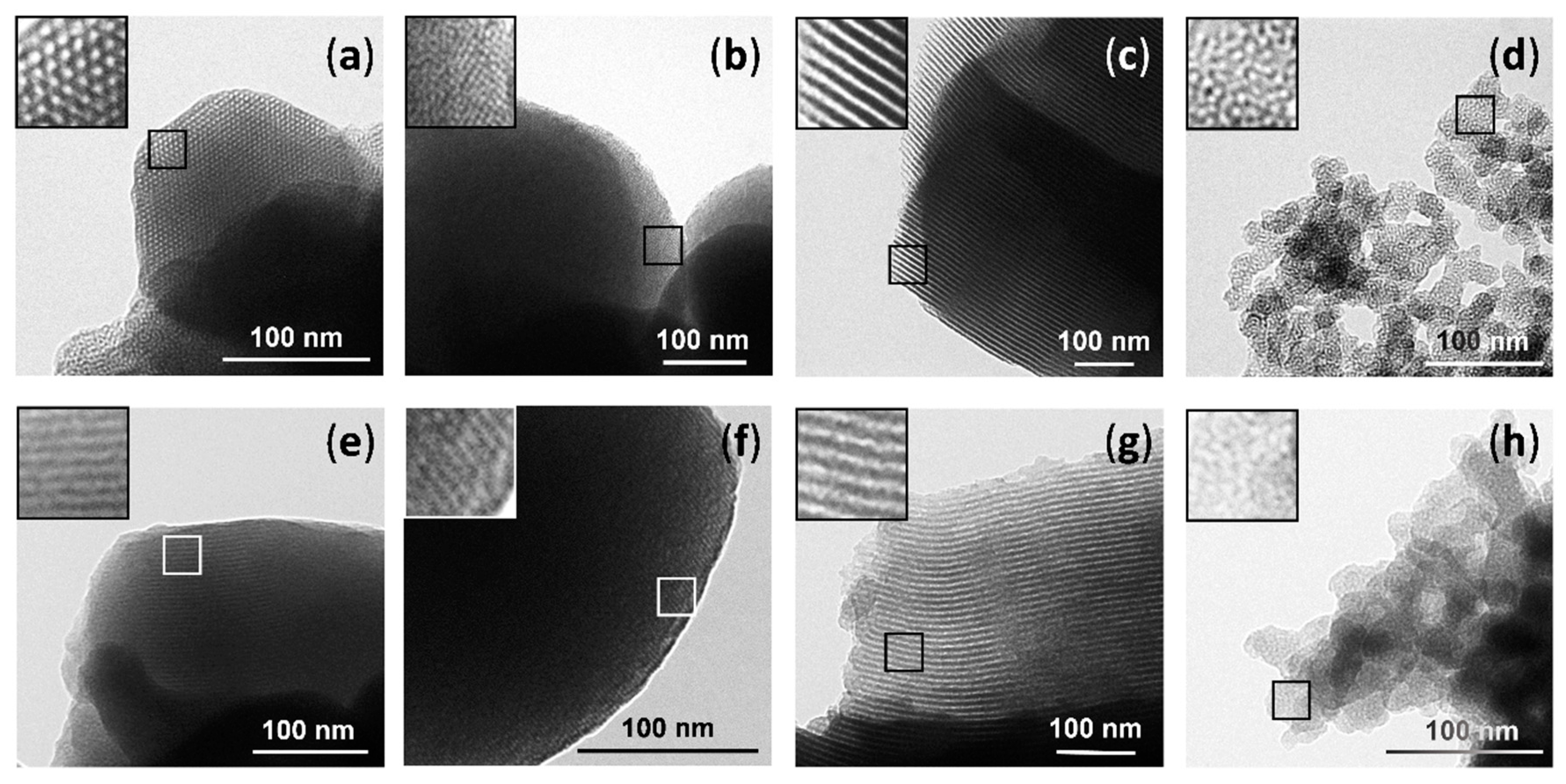
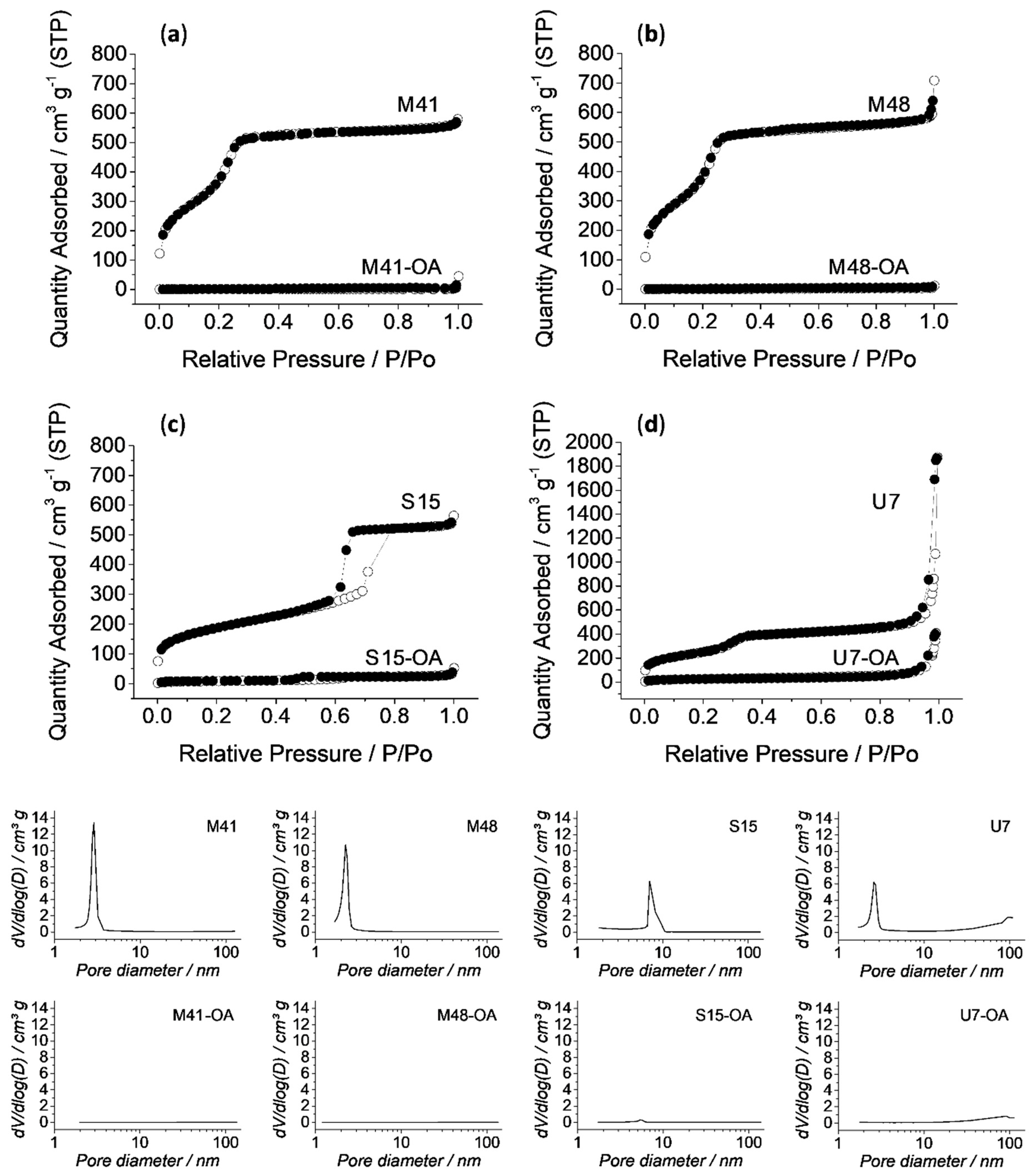
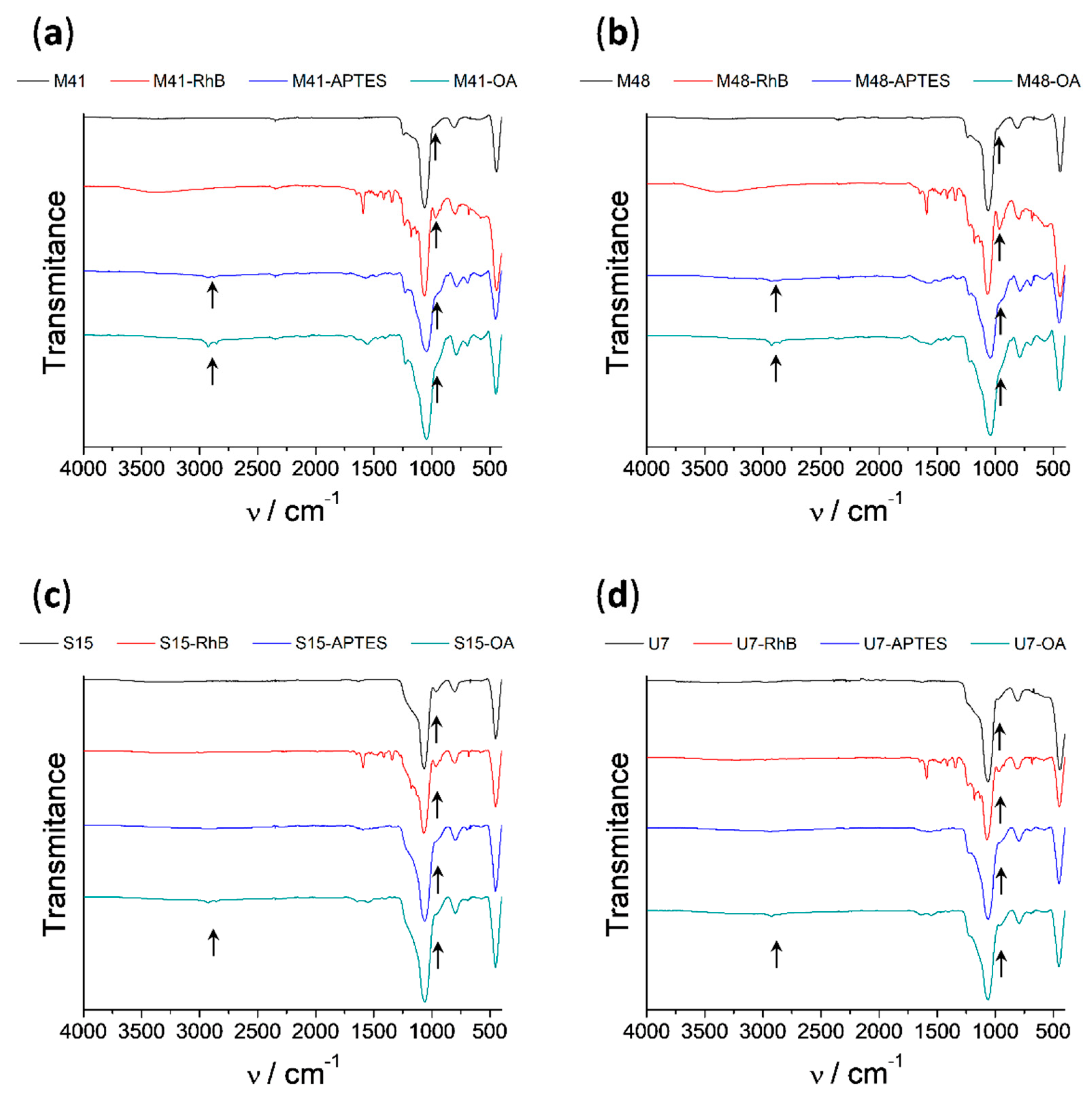

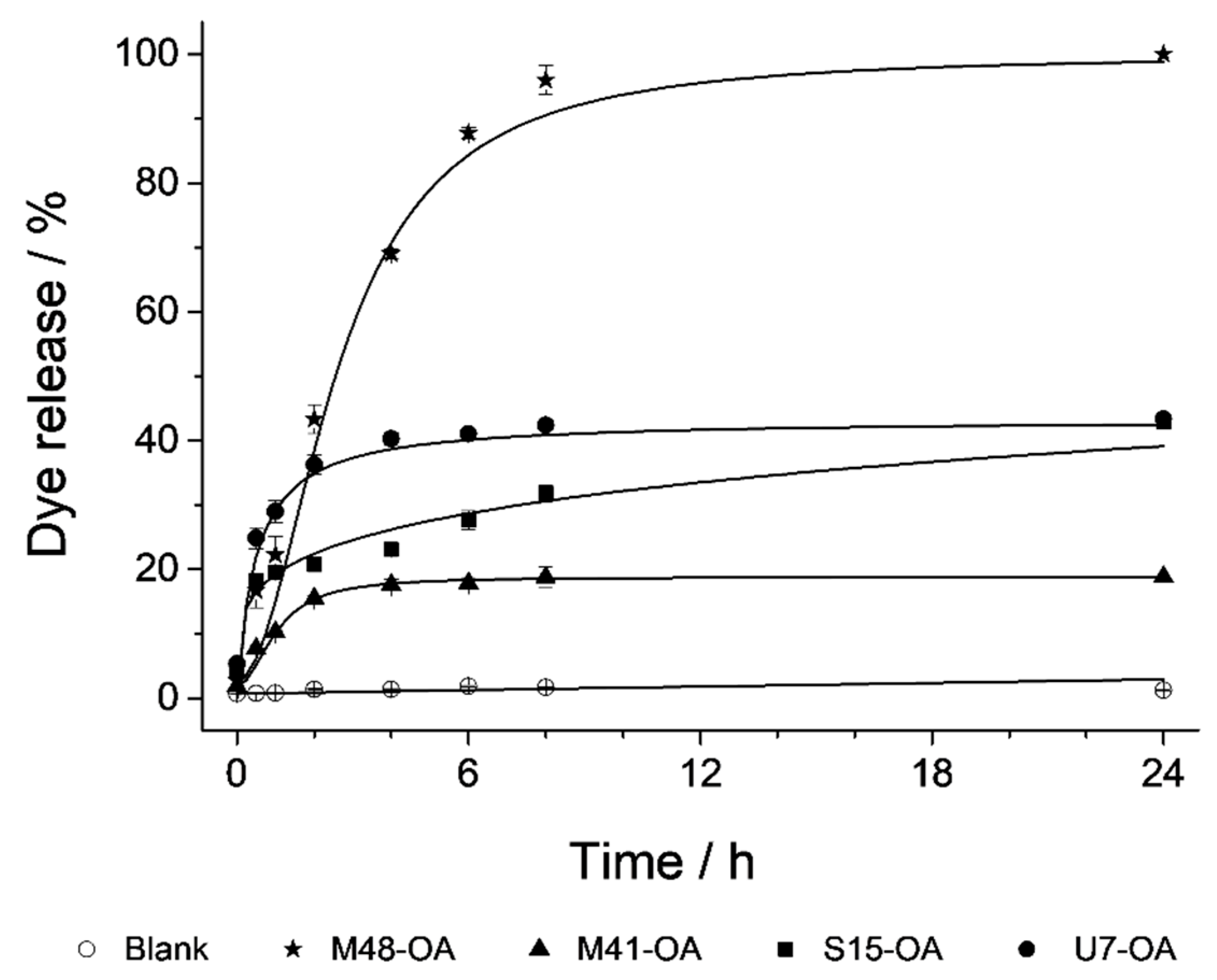
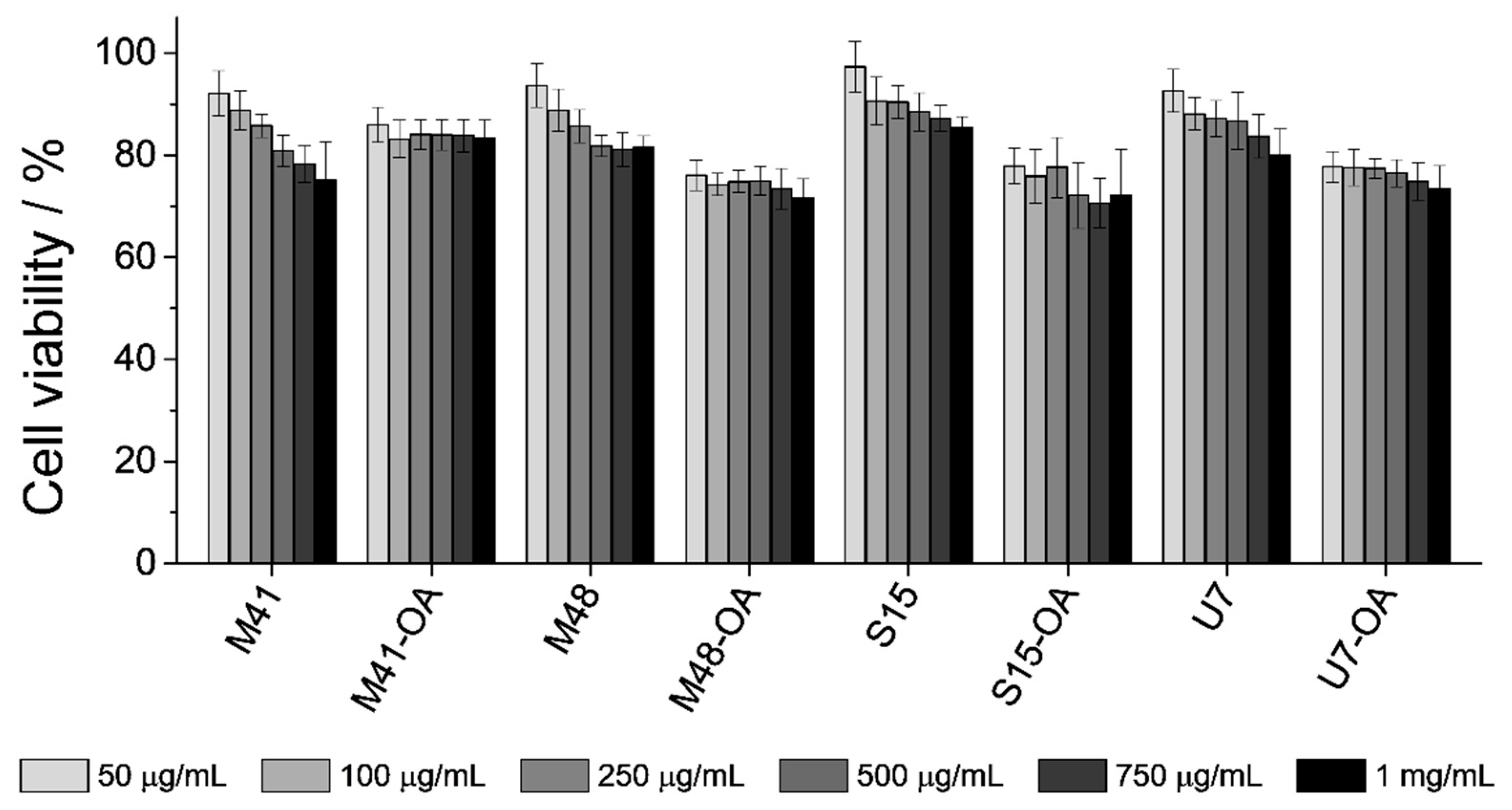
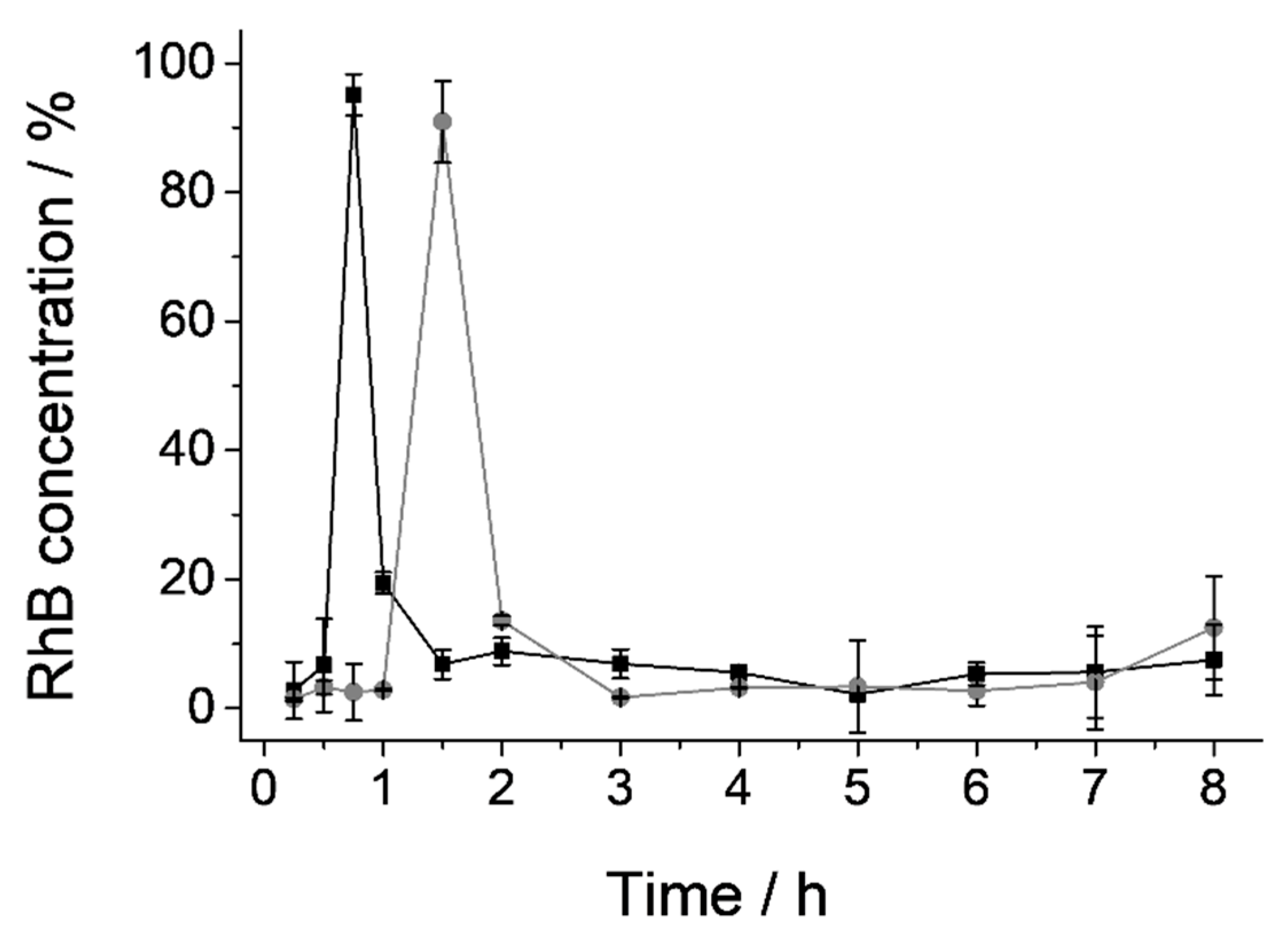
| SBET (m2 g−1) | Pore Volume (cm3 g−1) | Pore Size c (nm) | |
|---|---|---|---|
| M41 | 1074.0 | 1.0 | 3.0 |
| M41-OA | 2.4 | 0.0 | - |
| M48 | 1355.4 | 1.0 | 2.3 |
| M48-OA | 0.1 | 0.0 | - |
| S15 | 670.7 | 0.8 | 5.4 |
| S15-OA | 31.3 | 0.0 | - |
| U7 | 922.1 | 0.7 a (0.8) b | 2.6 a (32) b |
| U7-OA | 96.4 | 0.07 a (0.4) b | - a (34) b |
| Solid | αRhB | αAPTES | αOA |
|---|---|---|---|
| M41-OA | 0.15 | 6.30 | 0.59 |
| M48-OA | 0.15 | 6.17 | 0.43 |
| S15-OA | 0.28 | 3.57 | 0.30 |
| U7-OA | 0.10 | 3.59 | 0.44 |
| Digestive fluid | M41-OA | M48-OA | S15-OA | U7-OA |
|---|---|---|---|---|
| Saliva | 0.01 ± 3·10−4 | 0.02 ± 9·10−4 | 0.01 ± 7·10−4 | 0.01 ± 4·10−4 |
| Gastric | 0.10 ± 0.01 | 0.16 ± 0.01 | 0.16 ± 0.02 | 0.07 ± 0.02 |
| Duodenal | 3.35 ± 0.23 | 6.58 ± 0.15 | 5.86 ± 0.16 | 8.68 ± 0.39 |
| Bile extract 24 h | 4.84 ± 0.24 | 25.71 ± 0.38 | 11.02 ± 0.33 | 11.15 ± 0.20 |
| System | Zero Order Equation (1) | First Order Equation (2) | Higuchi Equation (3) | Korsmeyer–Peppas Equation (4) | |||||||
|---|---|---|---|---|---|---|---|---|---|---|---|
| k0 (min) | r2 | k1 (min) | C0 | r2 | KH (min−½) | r2 | K (min−n) | n | b | r2 | |
| M48-OA | 0.3 | 0.98 | 0.0 | 7.4 | 0.7 | 4.01 | 0.97 | 0.99 | 0.77 | 1.76 | 0.995 |
| M41-OA | 0.1 | 0.8 | 0.0 | 4.3 | 0.6 | 1.25 | 0.97 | 1.52 | 0.45 | 0.71 | 0.97 |
| S15-OA | 0.1 | 0.6 | 0.0 | 9.2 | 0.5 | 1.8 | 0.8 | 1.71 | 0.45 | 5.50 | 0.87 |
| U7-OA | 0.2 | 0.7 | 0.0 | 27.9 | 0.5 | 3.08 | 0.90 | 3.21 | 0.45 | 6.36 | 0.92 |
© 2020 by the authors. Licensee MDPI, Basel, Switzerland. This article is an open access article distributed under the terms and conditions of the Creative Commons Attribution (CC BY) license (http://creativecommons.org/licenses/by/4.0/).
Share and Cite
Poyatos-Racionero, E.; González-Álvarez, I.; González-Álvarez, M.; Martínez-Máñez, R.; Marcos, M.D.; Bernardos, A.; Aznar, E. Surfactant-Triggered Molecular Gate Tested on Different Mesoporous Silica Supports for Gastrointestinal Controlled Delivery. Nanomaterials 2020, 10, 1290. https://doi.org/10.3390/nano10071290
Poyatos-Racionero E, González-Álvarez I, González-Álvarez M, Martínez-Máñez R, Marcos MD, Bernardos A, Aznar E. Surfactant-Triggered Molecular Gate Tested on Different Mesoporous Silica Supports for Gastrointestinal Controlled Delivery. Nanomaterials. 2020; 10(7):1290. https://doi.org/10.3390/nano10071290
Chicago/Turabian StylePoyatos-Racionero, Elisa, Isabel González-Álvarez, Marta González-Álvarez, Ramón Martínez-Máñez, M. Dolores Marcos, Andrea Bernardos, and Elena Aznar. 2020. "Surfactant-Triggered Molecular Gate Tested on Different Mesoporous Silica Supports for Gastrointestinal Controlled Delivery" Nanomaterials 10, no. 7: 1290. https://doi.org/10.3390/nano10071290
APA StylePoyatos-Racionero, E., González-Álvarez, I., González-Álvarez, M., Martínez-Máñez, R., Marcos, M. D., Bernardos, A., & Aznar, E. (2020). Surfactant-Triggered Molecular Gate Tested on Different Mesoporous Silica Supports for Gastrointestinal Controlled Delivery. Nanomaterials, 10(7), 1290. https://doi.org/10.3390/nano10071290







